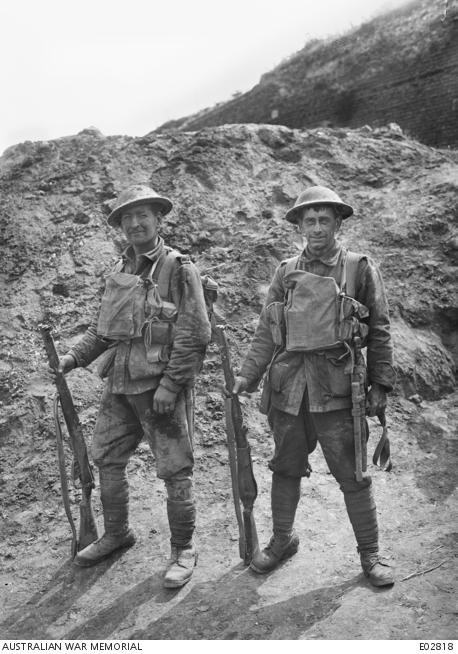Copyright Hunter

Front view of two diggers of the 5th Division, 4172 Private (Pte) George James Giles, 29th Battalion (left) and 4015 Pte John Wallace Anderton, 32nd Battalion, just out of the trenches, in full kit.
A moment of nervous anticipation hits me as I pick up the phone and dial the number. The phone starts to ring and the heart beat picks up a little. A voice on the other end of the line says “Hello?” I ask if she’s the relation of a First World War veteran I have been tracing. The reply is “Yes” and hours of work scouring through databases and the internet have paid off. I have found a relative the Australian War Memorial can ask for permission to use a collection in the Anzac Connections digitisation project.
The Anzac Connections project is a major web development project. It will progressively deliver new, digitised collections relating to the First World War to the Memorial’s website. The project also aims to improve search and discovery on the site, and provide ways for people to interact with the collection. The project was established to mark the 2015 centenary of the landing at Gallipoli. For each of the collections that go online, the Memorial, if it does not already have copyright permission, needs to acquire such permission from a living descendant.
The Memorial has systems in place to aid the search for copyright holders. A search template has been made to help speed up the searching process. Firstly, it covers the Memorial’s own database systems that store information about donations and existing copyright holders contact information. If there is recent contact information available than a letter and permission forms are sent to the last address or the Memorial will call the copyright holder.
If this first part of the process does not produce a copyright holder then the next step is to start searching other archives or files such as service records (the majority of First World War records have been digitised on the National Archives of Australia website), embarkation rolls and Red Cross Wounded and Missing files, both of which have been digitised on the Memorial’s website. These records can hold valuable information in tracking down living relatives for copyright permission for the Anzac Connections project.
To assist the Memorial in finding relatives, Ancestry.com is used. This website gives us access to such records on births, deaths and marriages, and also census and voting lists. While Ancestry.com does not give details of living descendants, it does however provide pieces of the jigsaw when included with information gathered from other sites such as Trove (National Library of Australia), The Ryerson Index (a list of deaths and newspaper obituaries) or the Commonwealth War Graves Commission website. Also a Google search can produce unexpected results and has produced information on copyright holders for the Memorial.
If after pursuing these avenues and no copyright holder can be found, the Memorial will then publish a blog on its website. The purpose of this blog is to ask the public for any information regarding possible living relatives of the service personnel whose collections are going to be included in Anzac Connections. This method has also produced information that has led to copyright holders being located.
The whole process of locating a living copyright holder can take either a few minutes or a few days depending on the nature of the collection. It is extremely rewarding to find a copyright holder, especially if they have no inkling to their relative’s involvement in the First World War. To hear the surprise and pride in their voices, that a long lost relative is going to have their private record collection digitised and published online as part of the Anzac Connections project, makes the hours of searching worthwhile.